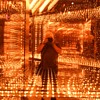Posted 12 years ago
 subversive…
subversive…
(7 items)
This old photograph was another score from an ephemera auction (there's a company here that runs them quarterly - always cool finds to be had.)
I posted the pic on a couple of sites, and was able to find out an amazing amount of information. The most helpful part in identifying where and when the picture was taken came from the broadsides posted in the background, which say, in part (bracketed text has been filled in, although not visible in the photo):
"...[TREN]T BRIDGE GROUND MONDAY MAY 16th"
"ALFRED SHAW'S BENEFIT"
"...[LO]RD SHEFFIELD'S 11 V. E[NGLAND]"
After much research by myself and others, the city has been identified as Nottingham, and it has been dated to 1892. The original photo is approx. 4"x5", mounted on some sort of cardboard (which I understand is fairly standard for amateur photos of the day), and is somewhat curved.
Alfred Shaw was a professional Cricketer, born 29th August 1842, died 16th January 1907. He apparently fell on some hard times, and two benefit cricket matches were held to raise funds for him, the second of which was the May 1892 match.
Pete Griffith, who maintains the online Cricket Archive, pointed me to this information: http://cricketarchive.com/Archive/Scorecards/3/3791.html
According to Pete, "[Shaw] received £130 from it, rain interfering with the match. (It was his second benefit match, the first, in 1879 produving £150 and also being rain-hit.)"
One of the sites I posted the pic on is forensicgenealogy.info - it was put up by the administrators as one of their weekly quizzes. The photo was also picked by site users as the favorite quiz from August 2007-August 2008, and there was also an August 2008 blog post which compiles even more details their users put together. It's astonishing how much information that can be developed just from the details of a photograph!
http://www.forensicgenealogy.info/contest_168_results.html
http://www.forensicgenealogy.info/survey_5_results.html
http://forensicgenealogy.info/blog/crossing-the-bridge



















What's especially interesting and nice about the image is its low angle of view and the man (right side) in motion. This could not have been shot with a portable field style view camera that would have been mounted on a tripod. The image was probably shot with a so called 'detective' camera of which many were available at the time.
A couple years back I posted here on CW an example of an English style detective camera. This would not be the camera that took your picture, but I do comment about the rise in popularity of candid street photography. Refer to: http://www.collectorsweekly.com/stories/1274-fallowfields-facile-an-1890s-conceal
Wonderful info, rniederman! Someone commented (on one of the pages I posted at the bottom, forget which one exactly) that Eastman had released a camera in 1888 that was something a person could use on the street, so it would have been something not many people would have seen - which might account for the double-take by the gentleman on the right. Or perhaps the photographer called out to him to get his attention just for the shot! It's one of my favorite photos, in any case, and made more so by the always-interesting (to me) process of digging up its history.
It is true that the original Kodak was introduced in 1888. George Eastman wanted to bring photography to the masses, which he did. However, his ground breaking camera was factory loaded with roll film that could make 100 pictures; each picture was a circular 2-1/2 inch image. The camera did not have a viewfinder but 'V' sighting lines embossed into the top leather. Your picture is definitely not small and circular. It also shows some pretty good composition which would have been very difficult without a viewfinder of some type. At the time, contact prints were usually made; therefore, it is more than likely your 4x5 inch picture was shot with a camera that held 4x5 inch glass plates.
As background, street photography predates Eastman's 1888 Kodak camera by many years, but it was Thomas Bolas who first suggested the "detective" camera concept in 1881. Detective cameras, basically a box with a hole for the lens in front, proved to be quite popular yet awkward to operate because plates had to be changed in between pictures. The Facile I mentioned earlier is an improvement on the original detective camera design because plates could be changed without having to change holders or go into a darkroom. But the Facile could not have made your image because its glass plates are smaller than 4x5 inches.
Also at this time, photographic emulsions were very sensitive which enabled photographers to make what is known as instantaneous photographs – meaning pictures could be shot with exposures lasting fractions of a second. The man on the right clearly demonstrates this.
Regardless, it’s a really great image and I’m glad you posted it.